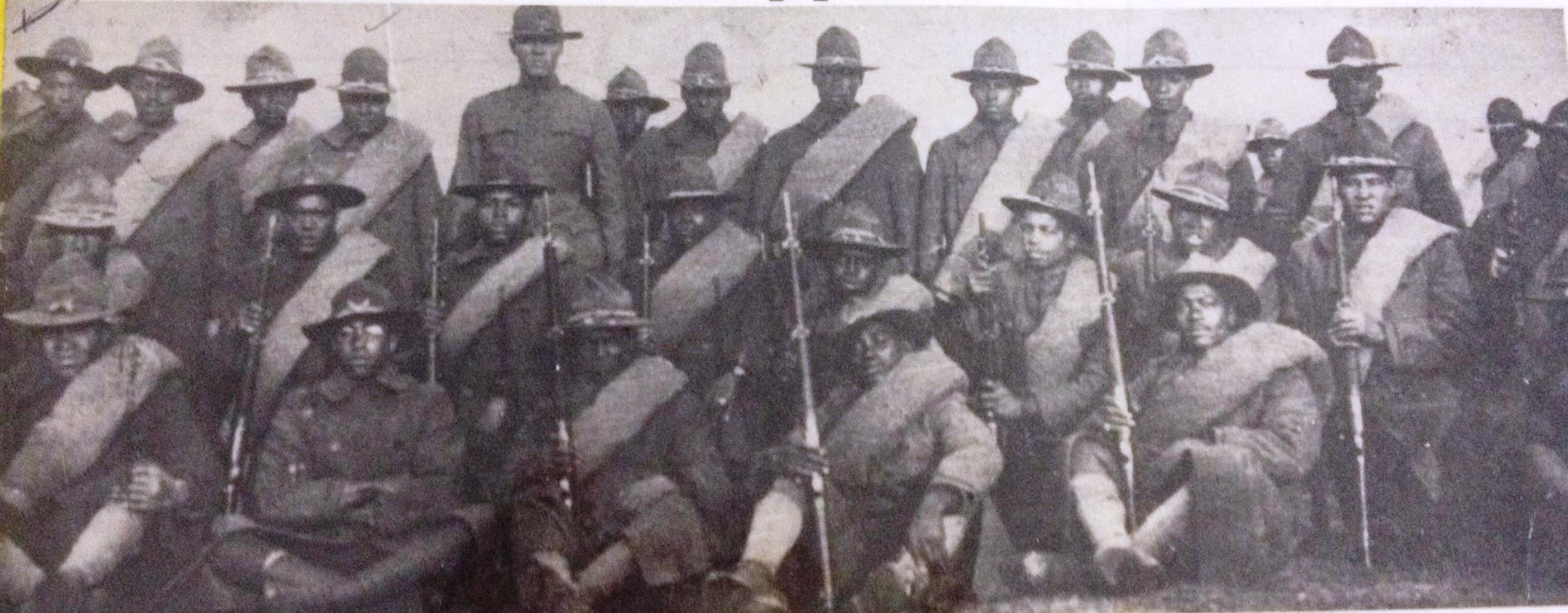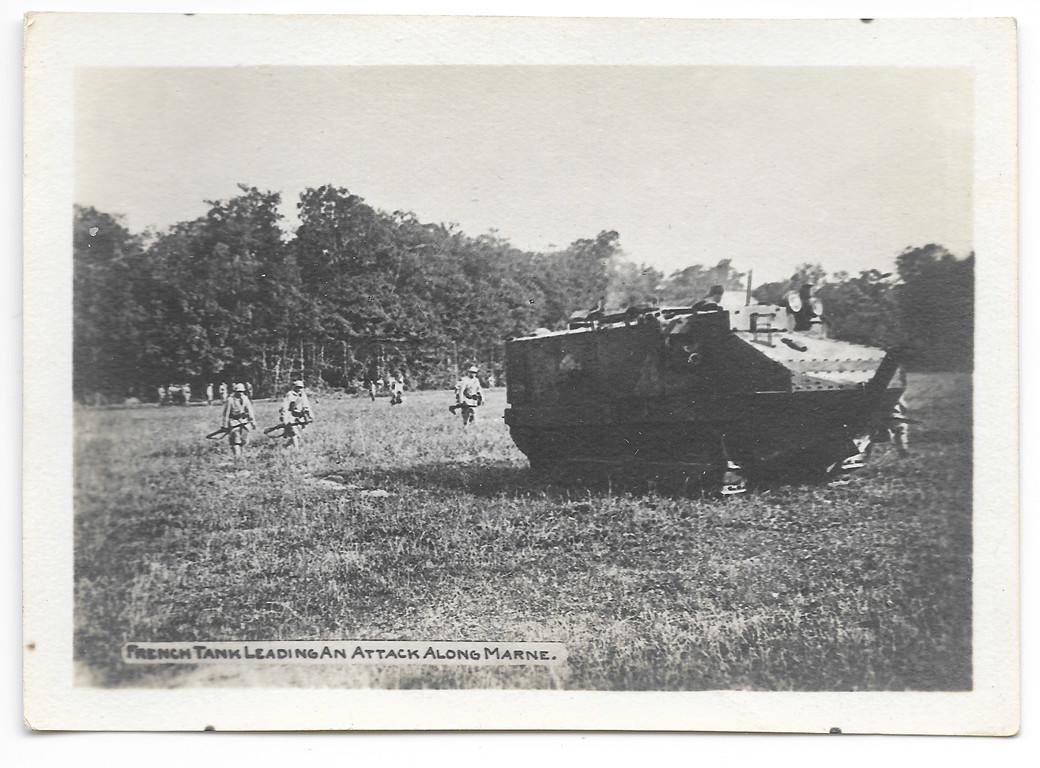Throwback Thursday: February 10, 2022
This article originally appeared on Moffat Library’s local history blog “Stories from The Vault” on Feburary 16, 2017. The original blog software was discontinued, but the article has been re-published here.

This week, we will be looking at a group of local soldiers who served their country bravely overseas, while fighting on the front lines of racial justice, and equality at home. In the end, their brave deeds would be remembered long after the final guns were silenced, and their contributions to American culture would help define the age that was to follow the First World War. They were the 369th Infantry, the “Harlem Hellfighters”.
In the summer of 1922, Blooming Grove Historian E.J. McLaughlin Jr., Washingtonville Historian Josephine Hallock, and Moffat Librarian Margaret H. Seaman were tasked by the New York State Historians James Sullivan, and Alexander C. Flick with collecting information on the contributions by the residents of the Town of Blooming Grove during “The Great War”, or “World War One” (1914-1918) . Among the roll of over 100 names of soldiers, sailors, volunteers, and nurses, are 10 individuals whose service would blaze a path for future African Americans to represent America’s military abroad. Four of the ten were Robert Baldwin, James Chambers, Hector Lewis, and James Lewis of Company K, 15th New York National Guard.
When the United States officially declared war on Germany in April 1917, the War Department, which oversaw military enlistment, faced the dilemma of opening its doors to African Americans for overseas service. Since the American Civil War, African Americans had served in segregated military units, such as the 54th Massachusetts. The famed “Buffalo Soldiers” of the 9th and 10th Cavalry, as well as the 15th New York National Guard, were some of the “Colored” regiments that were currently serving in the U.S. military. Enthusiasm for the war and a desire for Black Americans to prove themselves worthy of being treated as equal citizens drove thousands of African Americans to enlist. The War Department, unsure if Blacks would make “good soldiers”, at first turned many willing young men away. However, the demand for troops and pressure from groups such as the NAACP forced Secretary of War Newton D. Baker to appoint Emmett Scott, former secretary to Booker T. Washington, as a special liaison between the War Department and the African American community [1]. By the end of the war, 380,000 African Americans would serve in the U.S. military, with 200,000 being sent overseas as laborers or soldiers [2].
Of the African American units that would serve during the First World War, one of the most celebrated was the 369th Regiment, known to history as the “Harlem Hellfighters”. Formed from the 15th New York National Guard in 1917, the 369th was based out of Harlem, New York, but enlisted men throughout New York State, as well as parts of New Jersey. By June, 1917 the unit boasted 2,002 soldiers and 56 officers, the first New York State unit to reach this size for the war effort [3]. To maintain organization, and manage the regiment effectively, the regiment was divided into three groups of 800 men called “Battalions”. These battalions were composed of 3 to 4 “Companies”, smaller groups of 200 soldiers, labeled “A” through “K”. Robert Baldwin, James Chambers, Hector Lewis, and James Lewis of Washingtonville would all serve in Company K, Third Battalion, 369th Infantry.
Census records, as well as military service cards, give us some background information on these enlistees from Washingtonville. Of the soldiers from our area, James Chambers, 18 years old, was the youngest. According to the 1910 census, his father, a local farmer, was born in North Carolina in 1860, just before the American Civil War, and came to New York shortly after. James Lewis, enlisted on July 1st, 1917 at the age of 19. According to military records, he would serve in Company K from July 1917 to December 1918, before moving to Company I; the regimental band from December 1918 to January 1919, and finally Company E until his discharge in February, 1919. Hector Lewis, a 22 year old truck driver for Hallock & Nicholl, enlisted on July 1st, 1917. Hector would also serve in the regimental band of Captain James Reese Europe after being transferred from Company K in December 1918. Robert Baldwin was the oldest at 29, and worked as a laborer before enlisting on June 6, 1917.
Training commenced at Camp Whitman in Poughkeepsie, where they learned basic drill and weapons care. Their first assignment was guarding the railway lines that connected New York City to supply depots throughout New York State. In October, they departed for advanced training at Camp Wadsworth in South Carolina. During their time in South Carolina, the men of the 369th faced harsh treatment and racism by white business owners who refused to service them. Despite this, several White soldiers, who were also training at Spartanburg, boycotted any stores that refused to serve their Black comrades [4]. By the time the regiment departed South Carolina in November, they were fully equipped and ready to be sent overseas. The 369th left the United States for France on November 12th, 1917. Despite several mechanical failures aboard their cruise ship, the U.S.S. Pocahontas, the regiment arrived in Brest, France on December 27th, 1917.
The regiment arrived as part of the 93rd Division, one of two “All Black” combat divisions serving in the American Expeditionary Force (or A.E.F.). Like many young men who had joined the service at the outbreak of war, the men of the 15th New York, were eager to serve on the front lines, hoping to prove themselves as soldiers. However, the 15th found themselves performing menial duties; such constructing roads, unloading supplies, and guarding German prisoners. These duties, while essential, were often given to “Stevedores” or civilian laborers [3]. By July 1918, the division would be transferred to French service, in order to fulfill America’s obligation to offer troops to serve under allied command. The 15th New York was then sent to Givry-en-Argonne, where they were re-designated the “369th Regiment d’Infanterie Etats Unis”, and given French helmets and equipment [3]. Regardless of whose flag they served under, the men of the 369th would become well known by friend and foe for their bravery and determination under fire.

It is impossible to recreate the horrors of battle, and mental stress soldiers faced during the First World War. This conflict saw the first use of tanks, and chemical weapons in warfare. It also validated the role of the airplane as vital to spotting, and eliminating targets on the ground. The increased firepower of machine guns, and heavy artillery led military leaders to believe the best offense was a good defense, and opposing forces dug complex trenches to defend what little territory was gained from crossing “No Man’s Land”. Although we have no known written record from Washingtonville’s Hellfighters of their personal experiences, some letters from their comrades in Company K. have survived to give us a glimpse of what life was like on the front lines. In April 1918, Corporal Elton West of Middletown wrote his mother from the trenches of the Main de Massiges, France: “Where we are stationed you can hear the French artillery every night when they open an attack. The sky is practically covered with light from the cannonade. Everybody is cautioned to wear a gas mask for fear there might be an attack at any time. However, the nearer we get to danger, the less we pay any attention to it…While up [at the front line] we were housed in ‘dug-outs’ some 15 or 20 feet below the ground” [5]. Private A.C. Cheatam, also of Middletown wrote: “We are now just in the rear of the firing line and we go to sleep and awake amid the roaring of the big guns and the buzzing of the aeroplanes”. Private Cheatam would be severely wounded several days before this letter appeared in the Middletown Times Press on May 22, 1918 [5].

Shell fire, and orders to attack the opposing trench by going “over the top” were punctuated by occasional moments of rest behind the front lines. Corporal West writes: “At the present writing, I am about to go to the moving pictures just across the way. This will cheer us up after hard work in the trenches. Luckily, none of the boys was hurt, although the German shells dropped close by, throwing shrapnel and dirt onto us”. These shared experiences of danger, and homesickness only increased the camaraderie of the men of Company K. Private Cheatam wrote home: “Every one of the boys from Orange County is well and making good. We have a sort of club that we call the “O.C. Blossoms”, and we have a very good time under the condition of things” [5]. The nickname of the group was inspired by the 124th New York State Volunteers, a regiment raised in Orange County during the American Civil War [6].
The 369th would end up serving 191 days on the front line trenches. During that time, they fought in the Champagne-Marne Offensive (July 15 – August 6, 1918), and Meuse-Argonne Offensive (September 26 – November 11, 1918), two major campaigns which led to the defeat of Germany and her allies. These victories came at a cost for the 369th and the men of Company K. On September 28th, 1918, Private James Chambers of Washingtonville was severely wounded in the opening phases of the Meuse-Argonne offensive, which resulted in heavy casualties as a result of: “most of the fighting was hand to hand” [3]. The ferocity of this regiment in the face of battle would earn their nickname “The Harlem Hellfighters” [7]. By the end of the First World War, the 369th suffered a total of 1,500 men killed and wounded. Fortunately Corporal Robert Baldwin, and Privates James Chambers, Hector Lewis, and James Lewis, would all return home safely.
The 369th arrived home in New York on February 9th, 1919 to a large crowd of spectators. Their exploits, having been reported in local papers such as the Middletown Times Press, as well as national publications like the Saturday Evening Post. For their service, over one-hundred members of the regiment were awarded the Croix de Guerre, and/or Legion of Honor, the two highest awards for military bravery and conduct by the French Government [3]. Soldiers such as Sergeant Henry Johnson of Albany, and Private Needham Roberts of Trenton, New Jersey became household names due to their actions. On May 14, 1918, they successfully fought off a German patrol of 24-30 men. After they had exhausted their ammunition, the two continued to defend themselves using the butts of their rifles, grenades, bayonets, and a bolo knife. Both survived, and for his service Sergeant Henry Johnson was posthumously awarded the Distinguished Service Cross in 2003, which was upgraded to a Medal of Honor in 2015 [1] [8].
For their parts in the “Great War”, Corporal Robert Baldwin, and Privates Robert Baldwin, James Chambers, James Lewis, and Hector Lewis would return to their lives in Washingtonville secure in the knowledge that they had done their duty. Corporal Baldwin’s service record could be applied to many of his compatriots in which it states “One hundred ninety one days in first line trenches and has at all times shown himself to be a man of ability and great bravery. He has a Victory medal”.
Despite returning home to a segregated America, the deeds of these men and their regiment have left an indelible mark on the military and social history of the United States. According to historian Richard Rubin, the 369th’s victory parade, which drew crowds from across racial and social lines, could be seen as the beginning of America’s Civil Rights Movement [1]. James Reese Europe’s regimental band, known for playing popular jazz and ragtime pieces, toured throughout France during the war. The 369th band would be credited with introducing the genre to Europe, while inspiring a future generation of Jazz musicians at home [9]. There have since been many books, documentaries, and monuments dedicated to the 369th , but the closing words of W.E.B. DuBois in his 1919 essay “Returning Soldiers” illustrates the mark on history these men would leave:
“We Return.
We return from fighting.
We return fighting.
Make way for Democracy! We saved it from France, and by the Great Jehovah, we will save it in the United States of America, or know the reason why.” [10]
Sources

